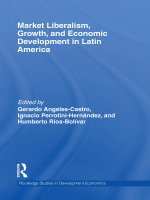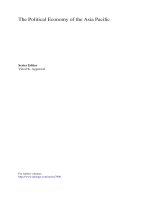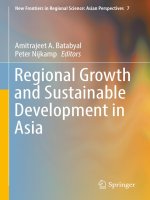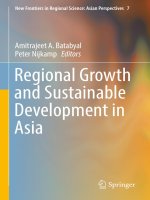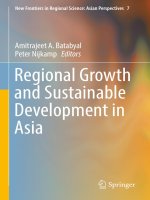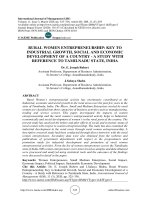Economic growth and economic development 154
Bạn đang xem bản rút gọn của tài liệu. Xem và tải ngay bản đầy đủ của tài liệu tại đây (86.56 KB, 1 trang )
Introduction to Modern Economic Growth
may work without making functional form assumptions on the aggregate production
function, but may also sometimes lead to misleading answers.
As a byproduct of investigating this question, we will see that the calibration
approach is in fact a close cousin of the growth-accounting exercise (and for this
reason, it is sometimes referred to as “levels accounting”).
Recall equation (3.4), where we constructed TFP estimates from a general constant returns to scale production function (under competitive labor markets) by
using average factor shares. Now instead imagine that the production function that
applies to all countries in the world is given by
F (Kj , Hj , Aj ) ,
and countries differ according to their physical and human capital as well as technology–
but not according to F . Suppose also that we have data on Kj and Hj as well as
capital and labor share for each country. Then a natural adaptation of equation
(3.4) can be used across countries rather than over time. In particular, let us a rank
countries in descending order according to their physical capital to human capital
ratios, Kj /Hj (use Exercise 3.1 to think about why this is the right way to rank
countries rather than doing so randomly). Then we can write
(3.27)
xˆj,j+1 = gj,j+1 − α
¯ K,j,j+1 gK,j,j+1 − α
¯ Lj,j+1 gH,j,j+1 ,
where gj,j+1 is the proportional difference in output between countries j and j + 1,
gK,j,j+1 is the proportional difference in capital stock between these countries and
¯ K,j,j+1
gH,j,j+1 is the proportional difference in human capital stocks. In addition, α
and α
¯ Lj,j+1 are the average capital and labor shares between the two countries.
These can only be computed if we can observe capital and labor shares in national
income by country. The estimate xˆj,j+1 is then the proportional TFP difference
between the two countries.
Using this method, and taking one of the countries, for example the United
States, as the base country, we can calculate relative technology differences across
countries. While theoretically attractive, this levels-accounting exercise faces two
challenges. One is data-related and the other one theoretical.
140
